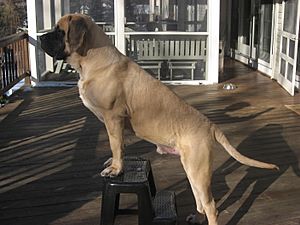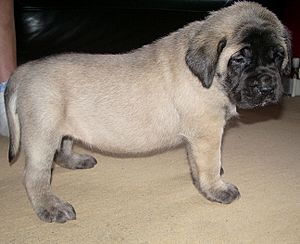English Mastiff facts for kids

An English Mastiff
|
|||||||||||||||||||||||||
| Other names | Mastiff | ||||||||||||||||||||||||
|---|---|---|---|---|---|---|---|---|---|---|---|---|---|---|---|---|---|---|---|---|---|---|---|---|---|
| Origin | England | ||||||||||||||||||||||||
|
|||||||||||||||||||||||||
|
|||||||||||||||||||||||||
| Domestic dog (Canis lupus familiaris) | |||||||||||||||||||||||||
The English Mastiff is a very large and powerful dog breed. People often just call them the Mastiff. They are known for their huge size, big heads, and short coats.
Mastiffs are famous for being gentle and loving, even though they look very strong. They have a special black "mask" on their face. These dogs have a long history, going back to ancient times. Modern Mastiffs became more common in the 1880s. They are one of the heaviest dog breeds in the world!
Contents
What Does an English Mastiff Look Like?
English Mastiffs are truly massive dogs. They have a broad skull and a head that looks quite square. They are considered the largest dog breed when it comes to their weight. They are usually a bit heavier than a Saint Bernard.
These dogs have a very deep and wide body, especially between their front legs. This makes their front legs stand wide apart. Male Mastiffs are at least 30 inches (76 cm) tall at the shoulder. Females are at least 27.5 inches (70 cm) tall. A male can weigh from 150–250 pounds (68–113 kg), and a female can weigh from 120–200 pounds (54–91 kg). Some very large Mastiffs can even weigh 300 pounds (140 kg) or more!
Mastiff Coat Colors
Mastiffs have a short, smooth coat. Sometimes, a Mastiff might have longer hair, but this is rare. The main colors for English Mastiffs are apricot-fawn, silver-fawn, fawn, or dark fawn-brindle.
All Mastiffs must have a black mask on their muzzle, ears, and nose. They also have black around their eyes. The fawn color can be a light silver or a golden yellow. Apricot can be a reddish color or a deep, rich red. Brindle means they have stripes, which should be clear and even.
What is the Biggest Mastiff Ever?
The heaviest dog ever recorded was an English Mastiff named Aicama Zorba of La Susa. He weighed an amazing 343 pounds (155.6 kg)! In 1989, when he was 7 years old, Zorba was 37 inches (94 cm) tall at the shoulder. He was also 8 ft 3 in (251 cm) long from his nose to his tail. That's about the size of a small donkey!
What is the English Mastiff's Personality Like?
Mastiffs are known for their wonderful temperament. They are often described as being both grand and good-natured. They are also very brave and gentle.
The American Kennel Club says that Mastiffs are powerful yet gentle and loyal dogs. Because of their large size, they need a lot of space. This means they are usually best suited for living in the countryside or in a suburban area with a big yard.
Keeping Your Mastiff Healthy
Mastiffs are very large dogs, so they need the right food and exercise to stay healthy. It's important not to let young Mastiffs run too much for their first two years. This is because their bones and joints are still growing quickly. They can gain over 5 lb in just a few weeks!
Even though they grow fast, Mastiffs still need regular exercise throughout their lives. This helps them stay active and prevents health problems. They should also have a soft place to sleep to avoid issues like calluses or arthritis.
The average lifespan for a Mastiff is about 7 years. However, some can live to be 10 or 11 years old.
Common Health Concerns
Some common health problems for Mastiffs include hip dysplasia (a hip joint problem) and gastric torsion (a serious stomach condition). They can also sometimes have problems with obesity (being overweight) or certain types of cancer.
When buying a purebred Mastiff puppy, experts suggest that the parents should be tested for hip and elbow problems. They should also be checked for thyroid issues and a certain eye condition called PRA.
Mastiffs can live in apartments, but they must get enough exercise. It's best to feed Mastiffs two or three smaller meals a day instead of one large meal. This can help prevent gastric torsion.
The History of the English Mastiff
Mastiff-like dogs have been around for a very long time. There are ancient sculptures from Mesopotamia (a region in the Middle East) from over 3,500 years ago that show dogs similar to Mastiffs.
Ancient Times to the 1800s
These dogs might be related to the powerful dogs that fought in Roman arenas. When the Romans came to Britain, they found strong British dogs called Pugnaces Britanniae. The Roman poet Grattius wrote that these British dogs were even better than the famous Greek Molossus dogs when it came to bravery in battle.
The Greek historian Strabo also wrote that dogs were sent from Britain to hunt and were used as war dogs by the Celts. Some people think these dogs came to Britain with the Phoenicians around 600 BC. The first written records of these dogs in England date back to 55 BC, when Julius Caesar saw them during his invasions. Many were sent to Italy to become fighting dogs.
Another important ancestor of the English Mastiff was likely the Alaunt. These dogs were brought to France by a group called the Alans in the 5th century.
The word "Mastiff" might come from the Old English word "masty," which means "powerful."
In 1415, during the Battle of Agincourt, a Mastiff protected its wounded owner, Sir Peers Legh, for many hours. This Mastiff later became the start of the famous Lyme Hall Mastiffs. These dogs were very important in creating the modern Mastiff breed centuries later.
From the 1800s to World War I
In 1835, a law was passed in the United Kingdom that stopped animal baiting. This might have led to a decrease in aggressive Mastiffs. However, Mastiffs continued to be used as guards for large country homes and businesses.
Serious breeding of Mastiffs began in the 19th century. Breeders like J.W. Thompson and T.V.H. Lukey worked to create the Mastiff we know today. They combined different lines of dogs, including some from the Alpine Mastiff breed.
One very important dog was named Lion, owned by Captain John Garnier. Lion's puppy, Governor, is the ancestor of all male Mastiff lines that exist today.
By the 1880s, the breed became more consistent in its look. The American Kennel Club (AKC) officially recognized the Mastiff in 1885. However, the number of Mastiffs in the US slowly went down until World War I. By the end of the war, the breed was almost gone outside of Great Britain.
After World War I
After World War I, a dog named Beowulf, born in Canada, helped restart the breed in North America. In Britain, almost all Mastiff breeding stopped during World War II because of food rationing. After the war, most puppies died from a disease called canine distemper. Only one female puppy, Nydia of Frithend, survived to adulthood.
Because of this, Mastiffs from North America were brought back to Britain to help rebuild the breed. This means that all Mastiffs today are descended from a very small group of dogs. In 1959, a Dogue de Bordeaux from France was even added to the Mastiff gene pool in the U.S.
Since then, the Mastiff breed has slowly recovered in Great Britain and has become popular worldwide.
Famous English Mastiffs
- "Carlo" from the Sherlock Holmes story "The Adventure of the Copper Beeches" by Sir Arthur Conan Doyle.
- "Chupadogra" (also called "Buster") from the 2010 film Marmaduke.
- "Crown Prince", an important dog in the history of the modern Mastiff breed.
- "Hercules" (also called "the Beast") from the film The Sandlot.
- "Goliath" (also called "the Great Fear") from the film The Sandlot 2.
- "Lenny" is a brindle English Mastiff from the 2009 movie Hotel for Dogs.
- "Mudge" from the "Henry and Mudge" children's books.
- "Zorba", officially known as the world's longest and heaviest dog.
See also
 In Spanish: Mastín inglés para niños
In Spanish: Mastín inglés para niños




